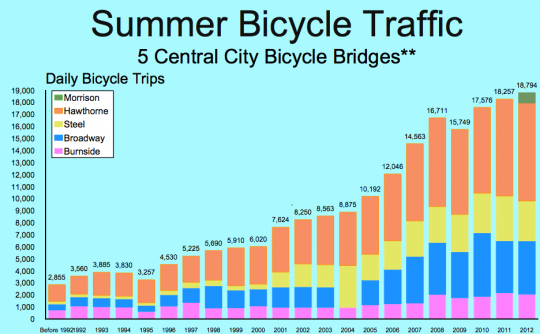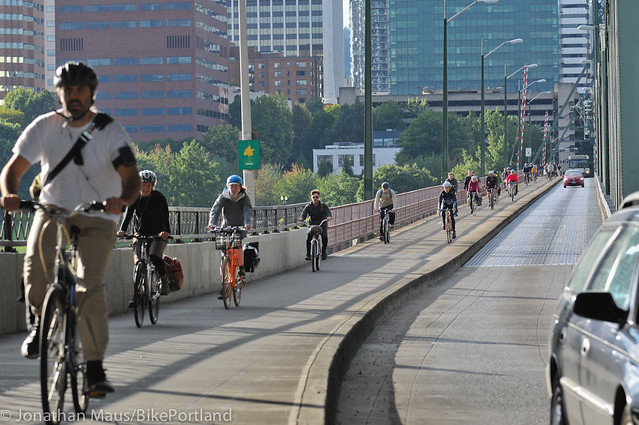
(Photo: J.Maus/BikePortland)
Correction appended.
Some or all of Multnomah County’s four busiest bridges across the Willamette River — the Broadway, Burnside, Morrison and Hawthorne — could see major biking and walking upgrades over the next fifteen years.
One possibility being discussed: physically separating bike and foot traffic on the Hawthorne Bridge by moving either biking or walking to one or two of the four auto-dominated lanes on the bridge deck.
Whatever recommendations might emerge, county staff decided in the last week to fast-track a proposed $1.4 million study of the possibilities for “improved bicycle and pedestrian operations and safety” within the next five years. Another $16.3 million is allocated to carry out half the recommendations by 2025, and another $16.3 million by 2030.
No sources for that money have actually been identified yet by the county. But the mere existence of the line items is a huge change from two months ago, when (as we reported at the time) the county’s $1.3 billion Willamette River Bridges Capital Improvement Plan included much less for people biking and walking.
“When they upgraded the Hawthorne people were saying, why the heck would you need such wide sidewalks on this? And boom! They were filled.”
—Andrew Holtz, Multnomah County Bicycle and Pedstrian Advisory Committee
As reported Thursday by the Bicycle Transportation Alliance, county staffers changed course after objections from its Bicycle and Pedestrian Advisory Committee and the BTA (not to mention dozens of great ideas from BikePortland readers). The county first created the new budget items, and then fast-tracked the first half of them.
“The congestion on the Hawthorne is already a problem at times, and it’s certainly going to become more of a problem,” Andrew Holtz, a longtime member of the advisory committee, said Thursday. “Heck, we need to start studying this stuff yesterday. We can’t wait at all for figuring out what’s going to come and how do we accommodate the growth in bicycle and pedestrian transportation in the coming decades.”
BTA Engagement Manager Carl Larson agreed.
“Clearly the growth of traffic across the bridge has been coming from the people on the sidewalks, not on the decks,” he said.
Matt Picio, chair of the county advisory committee, said the Hawthorne’s sidewalks are running out of space.
“Nineteen percent of all traffic on the Hawthorne Bridge is bicycles,” Picio said. “We would like to see the council consider the possibility of lane reallocation.”
Picio’s numbers are accurate based on the number of vehicles across the bridge on an average weekday. But they don’t include people walking, people in the passenger seats of cars, or — most significantly — the 16,600 daily TriMet riders who cross the bridge in buses each day. Assuming an average 1.2 people per car (this is a standard occupancy estimate) and that the bridge draws about the same number of people on foot each weekday as it does on bikes, people biking account for 10 percent of the bridge’s traffic.
Advertisement
Larson said that though he hasn’t heard any county employees raise the issue of converting any of the Hawthorne’s four auto-dominated lanes to biking or walking, “we’ve discussed that openly with county folks in the room and they haven’t run screaming.”
Holtz said the county should look to its history. In 1999, it spent millions to widen the Hawthorne’s sidewalks from 6 feet to the current 10.
“People were saying, why the heck would you need such wide sidewalks on this?” Holtz said. “And boom! They were filled.”
“Cars aren’t going away; trucks need to move,” Holtz said. “But it’s a fact now that the Hawthorne Bridge is the bike-ped bridge. … That needs to be recognized, and we need to start looking at how do we help it to fulfill its mission.”
Correction 4/30: A previous version of this post contained several significant errors. It said $32.6 million would be spent by 2020. In fact, according to county spokesman Mike Pullen, only the planning study is scheduled to be complete by 2020 and the $32.6 million would be spent between 2020 and 2030. Also, the post said that the county’s bridge improvement plan previously included “nothing at all for people biking and walking.” This neglected planned elevators for people with disabilities, among other measures. We regret the errors.


